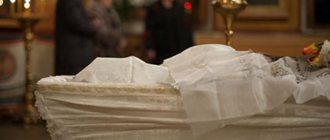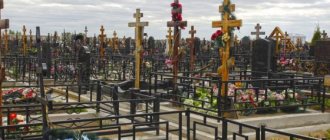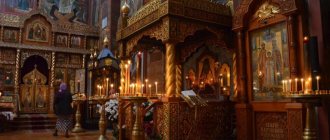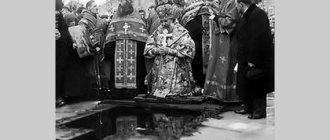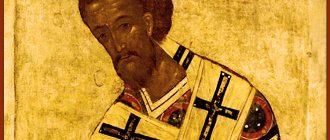The “rite of burial,” also known simply as the “rite of burial” or “funeral service,” is one of the most important Christian sacraments and one of the most well-known in culture, even among non-believers. Just as the sacrament of baptism greets a Christian at the beginning of his earthly life, the sacrament of funeral service escorts him into eternal life and, according to Christian dogmas, is a necessary step towards Salvation, and therefore it is a great misfortune for a Christian to go to the next world uninveterate.
In this case, the essence of the funeral service is outlined, according to the dogmas of the modern Russian Orthodox Church - in other Christian denominations this sacrament, like many others, may look different. In the Russian Orthodox Church it is done as follows. First, while the bells are ringing, the coffin with the body of the deceased is delivered to the temple (funeral services at home are possible, but as an exception). In a strictly defined order, the clergyman reads prayers over the body of the deceased. While singing prayers, mourners present at the service can approach the coffin and kiss the “crown” lying on the forehead of the deceased and the icon in his hands. The last stage of the sacrament takes place at the cemetery: the priest sprinkles a handful of earth on the body of the deceased, reads the last prayer, after which the coffin is nailed down.
Temples in Moscow cemeteries
What is the meaning of a funeral service?
A funeral service is a prayer service for the soul of a newly departed Christian. It benefits his soul and those who pray for him. See more about commemorating the dead.
There are three main themes in a funeral service: the theme of obligatory prayer for the deceased, the theme of mortal memory, and the hope of resurrection. The Gospel reading at the funeral and the apostolic reading speak specifically about the resurrection!
How to prepare the body of the deceased for a funeral service
Before the ceremony, the coffin is brought into the Church open. Next, all the ritual paraphernalia is placed in its place. Those present light candles, and the priest reads the established list of psalms and troparions. Last comes the prayer of permission, as if it were being said on behalf of the deceased. At the end, each of the mourners walks around the coffin and says goodbye to the deceased. The ritual ends with the placing of a shroud over the face of the deceased and the nailing of the coffin lid.
To conduct a funeral service outside (in a morgue, in a churchyard, etc.), a priest is invited and an agreement is made with him on the appropriate time and date. In general, the service is conducted according to the same rules, sometimes without individual psalms. The presence of candles in the hands of mourners is optional.
On what day is the funeral service held?
The funeral service is performed in the temple, usually on the third day after death; The first day is considered to be the day of death itself (that is, if a person died on Wednesday, then it is customary to bury him on Friday).
According to a special rite, the funeral service is performed on the days of Bright Easter Week: instead of sad funeral prayers, joyful solemn chants of Holy Easter are sung.
On the day of the Holy Resurrection of Christ and on the Feast of the Nativity of Christ, the deceased are not brought into the church and funeral services are not performed, moving it to the next day.
Question and answer
Is the funeral service performed the same for everyone?
There are four funeral rites, which differ in the text of the prayers: for laity, monks, priests and infants.
Why can the funeral service take place outside the church?
People began to hold funeral services outside the church in Soviet times, so as not to attract the attention of the authorities. Now this practice has been preserved in the form of funeral services in ritual halls and crematoria.
What, from the point of view of the clergy, is the meaning of the funeral service in absentia?
The purpose of this ritual is to gather loving people, friends, relatives at the tomb of the deceased, so that they can hear, as it were, the last word of the deceased addressed to them (after all, part of the funeral chants is spoken on behalf of the deceased), pray together, and ask the deceased for forgiveness for the fact that in life they did not pay him due attention, did not see each other for a long time, made mistakes, caused offenses and quarreled...
How is the funeral service performed?
The funeral service for the deceased is performed once, on the day of his burial. If it is not known for sure whether a person who once died was buried or not, then it is possible to order an absentee funeral service. The rites include stichera, the canon, and the reading of the Apostle and the Gospel. The funeral service must take place in the church. Since ancient times, according to tradition, the deceased was not only buried in the temple, but also left there for three days. And during this time, right up to the funeral, they read the Psalter for the deceased (see Psalter for the deceased).
When coming to church, you should remember, firstly, that the funeral service and commemoration are needed for prayer. And those who truly loved the deceased usually pray sincerely, that is, people close to him, those who worry about the soul of the deceased. Secondly, it would be good if people standing in the church took the text of the rite (you can download it in advance on the Internet) and understood what the choir was singing. Understanding what is happening will strengthen prayer and help the soul of a loved one.
It is customary for Orthodox Christians to bury them in a coffin, which remains open until the end of the funeral service (if there are no special obstacles to this). The body of the deceased in the coffin is covered with a special white cover (shroud) - as a sign that the deceased, who belonged to the Orthodox Church and united with Christ in her Holy Sacraments, is under the protection of Christ, under the auspices of the Church - she will pray for his soul until the end of time . A paper crown on the head of the deceased is a symbol of the crown, a symbolic designation of the fact that the deceased has gone into Eternal Life as a warrior who has won a victory on the battlefield.
All those accompanying the deceased pray with lit candles, signifying the Non-Evening Light of eternity. When saying goodbye, the icon on the chest and the forehead (crown) of the deceased are kissed. In the case when the funeral service takes place with the coffin closed, the cross on the coffin lid is kissed.
The simultaneous funeral of several deceased is not a violation of liturgical rules.
Funeral service or funeral service
The burial rite is the final stage in the triad of posthumous remission of sins. It is preceded by confession to the priest and absolution of the said bad deeds. It should be understood that hidden sins, which a person did not confess to before his death, will not be forgiven and will become the burden that will cast the soul from Heaven.
Funeral service
according to the Orthodox rite
RITUAL GOODS
ESSENTIALS FOR A FUNERAL
City funeral service
in St. Petersburg
Synonyms for the ritual being carried out are considered to be “mortal succession,” according to the Trebnik, and “funeral service,” for the words of prayers and psalms recited in a chant. The funeral rite is served directly over the deceased, preferably in the Church, in an appropriate setting. Recently, mobile services have become more common - at a cemetery or crematorium.
In some cases, reading prayers and psalms directly over the body is impossible. This happens in the absence of a corpse due to a plane crash over the sea, fragmentation of remains due to a bomb explosion, mass death of people due to the violence of natural disasters. Relatives of the victims are seriously worried about their deceased loved ones who went to the next world not inveterate. Indeed, in addition to unforeseen death, the soul of the deceased faces a tragic fate in the afterlife. Meeting the wishes of caring family members, the priests conduct the funeral service in absentia.
Who shouldn't have a funeral service?
A priest may refuse to perform a funeral service for a non-church person or an atheist. Non-believers, atheists, agnostics, occultists made their choice during their lifetime. And we must respect this choice, even if it seems terrible to us. Meeting the Holy God will only bring them torment.
The funeral service is not performed for the unbaptized (including infants), heterodox and non-Orthodox people, as well as those killed while committing a crime and suicides.
In the latter case, the deceased may be buried if he committed suicide in a state of insanity or madness. To do this, relatives can seek written permission from the ruling bishop by submitting a petition to him with an attached medical report on the cause of death of their loved one. For relatives of suicides, in 2011, the Rite of prayerful consolation of relatives of those who died without permission was adopted.
Assistance in conducting an absentee funeral service
The City Ritual Service in St. Petersburg expresses sincere condolences in connection with the tragedy that befell your family. We realize how painful it is for the believing citizens of our country to realize that their loved one has died and rested in peace without a funeral service. For our part, our company is ready to make every effort to ensure that the last service for the remains of your loved one is performed. More information about religious posthumous rituals can be found by phone. We advise on funeral issues 24/7.
What else can you do to help the soul of the deceased?
The funeral service and Christian burial of a deceased Christian, caring for his soul does not begin and does not end. It is advisable to perform prayer - cell (private) and public (in church). Notes about the deceased are submitted for proskomedia and memorial services (funeral prayers). The person submitting the note should not rely only on the prayer of the priest, but should also be prayerfully present at the service.
To help the soul of a loved one, we ourselves must come to God and get to know Him. We must live according to His commandments, communicate with Him in prayer, ask Him for mercy (including for the soul we want to help). For the sake of the soul of a loved one, we can give alms, perform deeds of mercy, fast, pray, and thereby reconcile the soul of the departed with God. God accepts everyone who turns to Him. So, there is no reason for despair; on the contrary, we still have time to do the necessary things that can help the souls of deceased relatives and friends.
Sacrament of the funeral service
Traditionally, a funeral service is held in a church or cemetery immediately before the lid of the coffin is closed. The prayers for departure are read in a certain order and in a chant. Hence the second name for the burial rite - funeral service. The priests insist on conducting the service in person, which must be preceded by the last confession and communion. After all, remission of sins is given only to those who sincerely repented of them during their lifetime.
It happens, however, that not only the person himself did not have time to free his soul from the severity of his sins, but his body is actually missing. For example, the ship on which he was cruising was wrecked. Or an unexpected weather event happened - a typhoon, a landslide, a flood. At the same time, the relatives of the deceased are concerned about a funeral appropriate for a Christian, with all the proper religious rites performed. For such cases, the church orders the priest to perform the funeral service in absentia for the deceased.
Turnkey funeral
How does a funeral service differ from “ordinary” prayer for the deceased?
Nowadays, we often have to deal with bewilderment: if God hears and answers our prayers in general, then, of course, he also answers prayers for the departed; Why then does the funeral service exist?
The consequence of a misunderstanding of the meaning and importance of the funeral service for the dead is that some treat this action merely as a formal, ancient, folk ritual, standing on a par with a memorial feast or the superstitious custom of throwing change into the grave.
Others, on the contrary, approach this prayer service mechanically or magically, believing that as soon as the funeral service is completed, the deceased will automatically be awarded the highest Heavenly Gifts.
In reality, neither the first nor the second judgment corresponds to the true nature and goals of the Christian funeral service.
The funeral service includes a consistent series of symbolic actions and prayers. During the funeral service, psalms, the Apostle, and the Gospel are read.
This helps the participants in the sacrament to better tune into a prayerful mood and promotes more sincere, concentrated, intense prayer. This is also facilitated by the presence (in front of the gathered relatives, friends, acquaintances...) of the coffin with the body of the deceased.
Unlike private prayers, prayers during a funeral service, which involves many farewells (seeing off), are conciliar in nature. And where at least two or three are gathered in the name of Christ, there He is in the midst of them (Matthew 18:20).
As a sign that the deceased was faithful to Christ and betrayed his soul to Him, a holy icon is placed on his chest. This is a symbol and sign that he is under the protection of Christ. Covering the body of a deceased Christian with a white cover - a shroud - has the same semantic meaning. Again, white color is associated with the light of Christ, moral purity. The paper aureole placed on the head of the deceased symbolizes the crown of a warrior of Christ.
All this together has a positive effect on the fate of the deceased, including during the passage of terrible ordeals by him (his soul).
How long does it last and what is needed for the funeral ceremony?
Let's list what is needed for the funeral ceremony:
Permissive prayer. A piece of paper with a written prayer is placed in the palm of the deceased.
Pectoral cross. They put it around the neck of the deceased.
Whisk. A strip of paper with words from Scripture is placed on the forehead. When saying goodbye, it is customary to touch her with your lips.
Icon. The face of the saint, the namesake of the deceased, is taken and placed on the side of the coffin. Or for men they choose the icon of St. Nicholas the Pleasant, and for women - the Virgin Mary.
Candles. They are distributed to everyone who comes and are lit just before the start of the service.
Relatives need to know how long the funeral service for the deceased lasts in order to calculate the length of the entire funeral ceremony. On average, a church service takes about 40-50 minutes. If the ceremony of following the dead is carried out on the road, then the time is reduced to 15-20 minutes.
In what situations is the absence of a body acceptable?
The burial rite is a special religious ritual performed over the body of the deceased. Unlike funeral chants and prayers, which can be performed by the relatives themselves, it has a regulated order of psalms and passages from holy scripture. Previously it was used as an addition to confession, but today it remains perhaps the only chance for the dead to enter the Kingdom of Heaven. After all, many people die without having time to repent of their deeds.
In fact, carrying out the procedure without the personal presence of the deceased has been practiced for quite some time. The first documented cases speak of funeral services for soldiers killed in battle. Since transportation of cargo 200 became possible only in the middle of the last century, all those killed in military battle were interred at the place of death. At the same time, comrades in arms took with them a handful of earth from the burial site and handed it over to the confessor in the hometown or village of the deceased. It was believed that the ceremony performed over the brought soil was equivalent to the funeral service for the deceased himself.
Over time, the tradition of absentee soul cleansing spread to other categories of citizens, including:
- Those who died by other than natural causes during natural disasters or man-made accidents;
- Victims of terrorist attacks;
- Patients of psychoneurological dispensaries;
- Died from diseases potentially dangerous to others (open form of tuberculosis, infectious diseases, etc.);
- People serving sentences in prisons.
Relatives of people who died and were buried abroad can count on remote performance of the main funeral ritual. In addition, the ritual is performed in absentia in case of reburial of remains.
The burial rite cannot be performed twice. If a person was buried at a funeral, there is no need to perform the ritual when re-burial after exhumation.
Death far from home
The most common reason for a funeral service after a burial is the death of a person far from his home. For example, a sailor may die while sailing, a tourist may die while abroad, or a military personnel may die on a foreign military base or during combat operations in another country. In these and similar cases, the dead are often buried not far from the place of death - sometimes for economic, sometimes for other reasons (for example, sometimes it may simply be impossible to remove the body of a military man from the scene of hostilities). Moreover, the relatives of the deceased may find out about the death and burial of a person long after it all happened. Obviously, in this case they had no opportunity to organize a funeral service before the funeral - as a rule, parish priests in such cases agree to conduct the ceremony after the fact.
Land rite
Priest Alexy Pluzhnikov draws the attention of believers to the misconception regarding the primary value of burial soil, which, after the funeral service, the priest sprinkles the body of the deceased in a cross shape before covering the coffin lid. In the case of an absentee funeral service, the relatives of the deceased are given thrice-blessed soil, which they must sprinkle on the grave of a loved one. According to him, there is no indication in the Church Charter that this land has any sacred properties. Until 1917, almost every cemetery in Russia had a church in which the funeral service was held, after which the clergyman walked along with the funeral procession to the grave and, at the moment the coffin was lowered into it, took the earth three times with a shovel and threw it into the hole. With this action, the priest demonstrated to those gathered the truth that we were created from the earth and will return to the earth. Thus, there is no holiness in the land rite, and its role increased somewhat in Soviet times, when believers, not being able to openly perform the funeral service for the dead, turned to the few existing churches for their funeral service in absentia, after which the priests gave them a handful of land so that they could complete it themselves. ritual Nowadays, the land has turned into almost the central object of funeral services, for which even unconscious relatives who order an absentee funeral find time.
Reason for refusal
All negotiations with the clergy can be carried out personally or you can entrust the organization of the ceremony to the ritual agent responsible for arranging the burial ceremony.
There are not many reasons why a priest may refuse a relative’s request, but nevertheless they do exist. In particular, the confessor has the right to reject requests for soul cleansing:
- An unbaptized person;
- A follower of one of the faiths not related to Orthodoxy;
- An atheist who publicly spoke about the absence of God;
- Missing person. The procedure is not carried out even after the person is declared dead in court.
The funeral rite is not performed for newborn babies.
A person who left a written request during his lifetime not to perform this ritual over his body cannot be inveterate. Also, the clergy can refuse to perform a funeral service in absentia if there are no visible obstacles to holding it in person.
The ceremony process and its features
The correspondence ritual is performed on any day except Christmas and the first day of Easter.
The sacrament is carried out after a preliminary agreement with the priest. The ceremony takes place:
- The funeral service is not mourning, but the birth of the soul into eternal life; the clergyman dresses in light-colored clothes. The symbol of celebration is candles held in the hands of people close to the deceased. The deceased left worldly life to meet the Lord.
- Prayers are performed before the eve, on a rectangular table with a marble plaque. A candlestick and lit candles are placed on the table.
- Instead of a body, a handful of earth is buried. The reading is carried out: verses from 17 kathismas, funeral troparia and litanies, irmos, sedalens, stichera. At the end, a special litany is read.
- If the deceased is not buried in the cemetery, the priest gives the relatives the land, the crown, and the funeral prayer. A crown is placed on the head of the deceased, the Holy Scripture is placed in the palm, the shroud that covers the body is sprinkled with earth in a cross shape. When the whereabouts of the deceased have not been established, funeral attributes after the funeral service in absentia are not issued. If the body of the deceased is cremated, the soil is placed in an urn containing the ashes.
Relatives should not leave the ceremony unless necessary. During the ritual you need to pray, turn to God in your own words.

